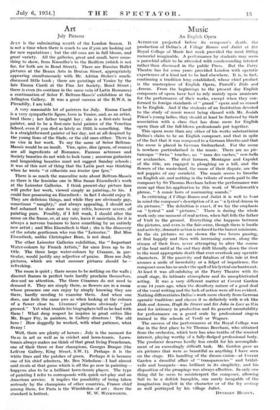Art
July Pictures
JULY is the culminating month of the London Season. It is not a time when there is much to see if you are looking out
for new reputations ; but the old ones are in full bloom, and great variety. All the galleries, great and small, have some- thing to show, from Knoedler's to the Redfern (which is not far, for both are in Bond Street). There are Russian Ballet pictures at the Beaux Arts in Bruton Street, appropriately appearing simultaneously with Mr. Adrian Stokes's much- discussed little book ; there are paintings of Venice by the late Emma Ciardi at the Fine Art Society, Bond Street ; there is even (to continue in the same vein Of Latin Romance) a continuation of Senor F. Beltran-Mass' exhibition at the Arlington Gallery. It was a great success at the R.W.S. in Piccadilly, I am told.
A very seasonable lot of painters for July. Emma Ciardi is a very sympathetic figure, born in Venice, and, as an artist, bred there ; her father taught her ; she is a first-rate local painter, and to be a first-rate local painter of the Venetian School, even if you died as lately as 1933, is something. She is a straightforward painter of her day, not at all despised by the young lions of the Slade, or the old ones either. There is no vice in her work. To say the same of Senor Beltran- Masses would be an insult. Vice, spice, dice (green, of course) are all ingredients of Romance. Famous actresses and Society beauties do not wish to look tame ; amorous guitarists
and languishing beauties must not suggest Sunday schools ; it was of this sort of thing that the-Latin poet was thinking when he wrote " et citharista sua tensior ipse lyra."
There is as much the masculine note about Beltran-Masses as there is the feminine one in Miss Susan Eisendieck's work
at the Leicester Galleries. I think, present-day picture fans will prefer her work, viewed simply as painting, to his. I could-face possessing an Eisendieck: in fact I should enjoy it.
They are delicious things, and while they are obviously gay, sometimes " naughty," and always appealing, I should not feel ashamed to show one to any critic, however severe, of painting pure. Possibly, if I felt weak, I should alter the name on the frame, or, at any rate, leaVe it uncertain, for it is always a nervous business to have something by an entirely
new artist ; and Miss Eisendieck is that ; she is the discovery of the astute gentlemen who run the "Leicester." But Miss Eisendieck, unlike Christopher Bean, is not dead.
The other Leicester Galleries exhibition, the " Important Water-colours by French Artists," for once lives up to its title. The three large water-colours by Cezanne, in par- ticular, would justify any adjective of praise. Here are July pictures, which are what summer pictures should be— refreshing.
The room is quiet ; there seems to be nothing on the walls ; discreet frames in perfect taste hardly proclaim themselves, demand no attention. The three Cezannes do not need to demand it. They are simply there, as flowers are in a room.
whose presence one can enjoy by simply knowing they are there, hardly needing to examine them. And when one does, one feels the same awe as when looking at the colours of a flower close to. Cezannes' pictures obviously " just growed." Yet what trouble his biographers tell us he had with them ! What deep respect he inspires in great critics like Mr. Roger Fry, in painters, in Gallery directors ! The old hero ! How doggedly he worked, with what patience, what frenzy !
Well, there are plenty of heroes ; July is the moment for thein in art as well as in cricket and lawn-tennis. Lawn- tennis always makes me think of that great living Frenchman, one of their three or four champions, Georges Braque (the Lefevre Gallery, King Street, S.W. 1). Perhaps it is the white lines and the patches of green. Perhaps it is because one of his chief admirers, Mr. Ben NicholsonI had almost said rivals at that game which is all the go now in painting- - happens also to be a brilliant lawn-tennis player. The type of painting I refer to corresponds with quick net-play and an American service; it implies the possibility of being taken seriously by the champions of other countries, France chief among them, for Paris is the Wimbledon of art ; there the










































 Previous page
Previous page